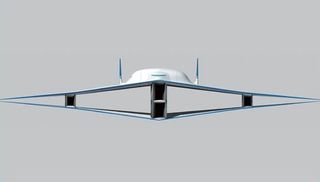New Biplane Design Stops Sonic Booms

Biplanes once ruled the skies in the pioneering days of aviation and World War I. Now the old aircraft design could make a comeback in the silent supersonic jets of tomorrow.
A newer version of the biplane could reach supersonic cruising speeds without causing ear-splitting sonic booms, according to computer simulations by MIT and Stanford University researchers. They built upon the design of German engineer Adolf Busemann, who originally envisioned triangular wings connected at their tips.
"The sonic boom is really the shock waves created by the supersonic airplanes, propagated to the ground," Wang says. "It's like hearing gunfire. It's so annoying that supersonic jets were not allowed to fly over land."
That was the case for the retired Concorde, which was the only civilian airliner to fly beyond the speed of sound, or Mach 1. Such supersonic aircraft built up compressed air at the front and back as it approached Mach 1, so that the sudden increase in air pressure upon breaking the sound barrier creates a sonic boom.
Busemann first calculated in the 1950s how a biplane configuration could cancel out the shock waves caused by each wing. But the two wings also create a very narrow channel that chokes off the air flowing between. The design also suffers from huge drag that could prevent the aircraft from reaching supersonic speeds.
The MIT and Stanford team tackled the problem by simulating how well Busemann's biplane performed at different speeds to come up with the best wing shape. They then combined the results from a dozen speeds and 700 wing configurations to pick an overall winning design — one that smoothes the inner wing surfaces to create a smoother air flow channel and bumps out edges of the wings.
Such design changes could cut the amount of fuel needed for a supersonic aircraft by half, Wang said. That could also help hypersonic military weapons or hypersonic civilian jetliners that travel at more than five times the speed of sound.
Sign up for the Live Science daily newsletter now
Get the world’s most fascinating discoveries delivered straight to your inbox.
"If you think about it, when you take off, not only do you have to carry the passengers, but also the fuel, and if you can reduce the fuel burn, you can reduce how much fuel you need to carry, which in turn reduces the size of the structure you need to carry the fuel," Wang says. "It's kind of a chain reaction."
A group of Japanese researchers has also tried designing a Busemann biplane capable of transforming its wings in midflight — another possible solution to the aerodynamic issues. For now, the U.S. team plans to move forward with a 3D model that can simulate other factors affecting the biplane design during supersonic flight.
This story was provided by InnovationNewsDaily, sister site to LiveScience. Follow InnovationNewsDaily on Twitter @News_Innovation, or on Facebook.
Most Popular


